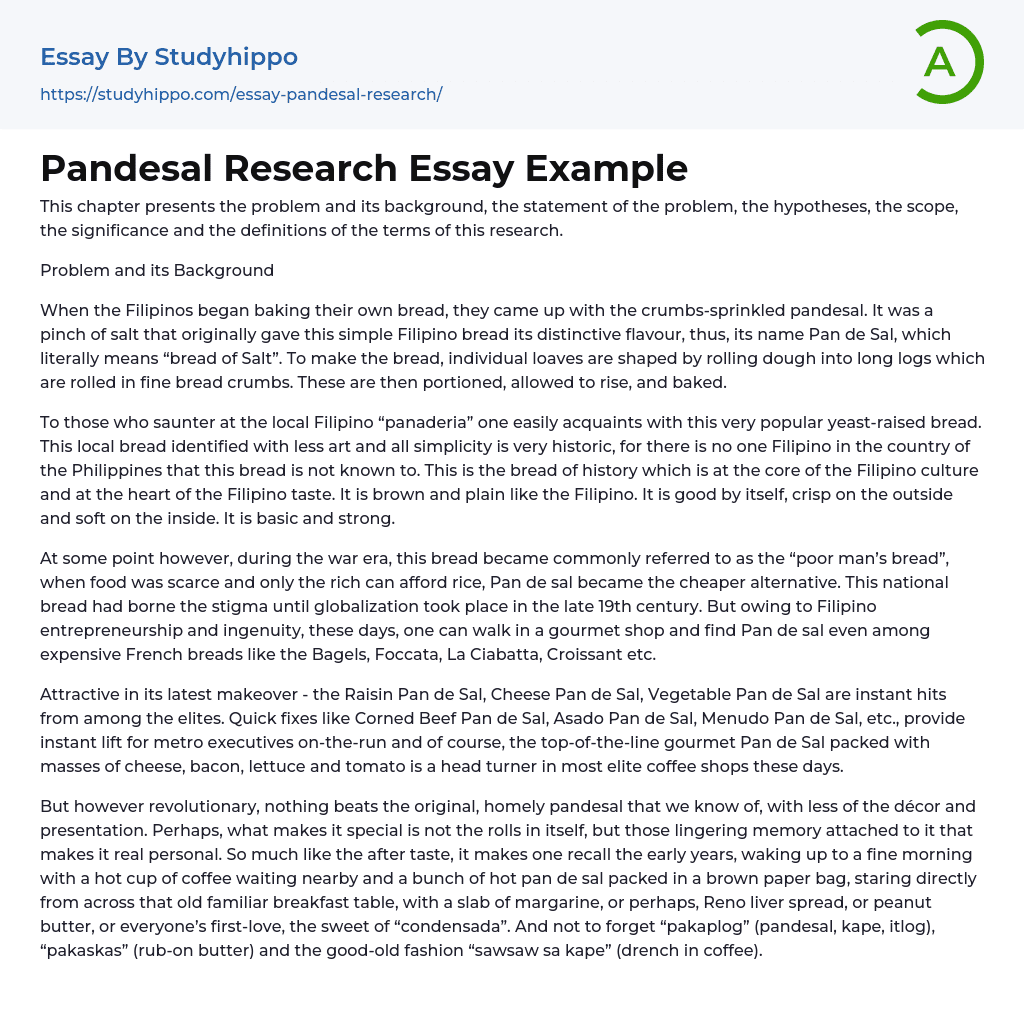This chapter presents the problem and its background, the statement of the problem, the hypotheses, the scope, the significance and the definitions of the terms of this research.
Problem and its Background
When the Filipinos began baking their own bread, they came up with the crumbs-sprinkled pandesal. It was a pinch of salt that originally gave this simple Filipino bread its distinctive flavour, thus, its name Pan de Sal, which literally means “bread of Salt”. To make the bread, individual loaves are shaped by rolling dough into long logs which are rolled in fine bread crumbs. These are then portioned, allowed to rise, and baked.
To those who saunter at the local Filipino “panaderia” one easily acquaints with this v
...ery popular yeast-raised bread. This local bread identified with less art and all simplicity is very historic, for there is no one Filipino in the country of the Philippines that this bread is not known to. This is the bread of history which is at the core of the Filipino culture and at the heart of the Filipino taste. It is brown and plain like the Filipino. It is good by itself, crisp on the outside and soft on the inside. It is basic and strong.
At some point however, during the war era, this bread became commonly referred to as the “poor man’s bread”, when food was scarce and only the rich can afford rice, Pan de sal became the cheaper alternative. This national bread had borne the stigma until globalization took place in the late 19th century. But owing to Filipino entrepreneurship and ingenuity, these days, one ca
walk in a gourmet shop and find Pan de sal even among expensive French breads like the Bagels, Foccata, La Ciabatta, Croissant etc.
Attractive in its latest makeover - the Raisin Pan de Sal, Cheese Pan de Sal, Vegetable Pan de Sal are instant hits from among the elites. Quick fixes like Corned Beef Pan de Sal, Asado Pan de Sal, Menudo Pan de Sal, etc., provide instant lift for metro executives on-the-run and of course, the top-of-the-line gourmet Pan de Sal packed with masses of cheese, bacon, lettuce and tomato is a head turner in most elite coffee shops these days.
But however revolutionary, nothing beats the original, homely pandesal that we know of, with less of the décor and presentation. Perhaps, what makes it special is not the rolls in itself, but those lingering memory attached to it that makes it real personal. So much like the after taste, it makes one recall the early years, waking up to a fine morning with a hot cup of coffee waiting nearby and a bunch of hot pan de sal packed in a brown paper bag, staring directly from across that old familiar breakfast table, with a slab of margarine, or perhaps, Reno liver spread, or peanut butter, or everyone’s first-love, the sweet of “condensada”. And not to forget “pakaplog” (pandesal, kape, itlog), “pakaskas” (rub-on butter) and the good-old fashion “sawsaw sa kape” (drench in coffee).
So it only came naturally a challenge to the authors of this research to think of ways on how to improve the experiences that Filipinos get over the classic bread without compromising the heritage that comes
with it. And as pandesal is made purely of flour, eggs, yeast, sugar, and salt, it entails that it contains only very minimal nutritional contents.
As an answer, the researchers thought to create a new recipe that will incorporate a cost efficient ingredient to the traditional mix to make an improve pan de sal that could market to the Filipino masses. This actually is one of the major considerations for this project for in fact, the size of the pan de sal is considered a gauge of the national economy. Sta. Maria explains that a good-sized pan de sal indicates good times at hand, while shrinking pan de sal means that the peso value is declining. With this approach it will address both the current economic standing as well as the preservation of this rich Filipino culture while adding uncompromised nutritional value.
There were several candidates for the added ingredient, like ampalaya, malunggay and etc., but as a final decision made, it was “kamote” or sweet potato (Ipomoea batatas) that came appealing to the writers of this thesis.
The sweet potato (Ipomoea batatas) is a dicotyledonous plant that belongs to the family Convolvulaceae. Although the leaves and shoots are edible, the starchy tuberous roots are by far the most important product from sweet potatos. Besides simple starches, sweet potatoes are rich in complex carbohydrates, dietary fiber, beta-carotene, vitamin C, vitamin B6, manganese and potassium and among all food staples like “mais” or corn, sweet potato remains to contain adequate nutritional contents at a very low price. Also, since historically speaking, along with pandesal, the Filipinos and “kamote” also go to trace a
long history.
- Food essays
- Genetically Modified Organisms essays
- Child Development essays
- Eating essays
- Breakfast essays
- Genetically Modified Food essays
- Milk essays
- Chewing gum essays
- Energy Drink essays
- Caffeine essays
- Chocolate essays
- vegetarian essays
- Weight Loss essays
- Anorexia essays
- Metabolism essays
- Diet essays
- Vitamin essays
- Dieting essays
- Junk Food essays
- Eating Habits essays
- Food Safety essays
- Food Security essays
- Beverages essays
- Cuisines essays
- Dairy essays
- Desserts essays
- Fast Food essays
- Bread essays
- Meal essays
- Meat essays
- Organic Food essays
- Rice essays
- Sugar essays
- Taste essays
- Beef essays
- Coconut essays
- Crowd essays
- Dinner essays
- Juice essays
- Sainsbury essays
- Cooking essays
- Ginger essays
- Oreo essays
- Drink essays
- Beer essays
- Wine essays
- Coffee essays
- Tea essays
- Cake essays
- Hamburger essays




